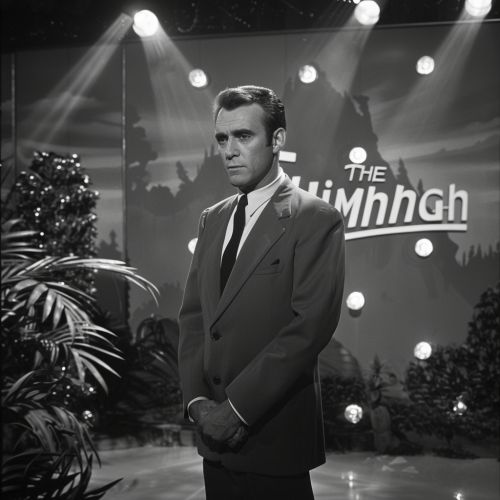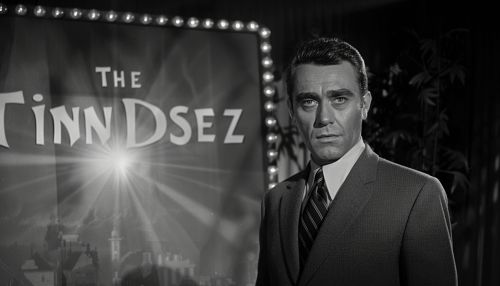The Twilight Zone
Introduction
"The Twilight Zone" is a term that has been used in various contexts, ranging from popular culture to scientific discourse. This article delves into the multifaceted nature of "The Twilight Zone," exploring its origins, applications, and significance across different fields.
Origins and Popular Culture
The term "The Twilight Zone" was popularized by the American television series created by Rod Serling in 1959. The show, which aired on CBS, is a seminal work in the science fiction and fantasy genres. It explored themes of paranormal phenomena, dystopian futures, and moral dilemmas, often with a twist ending that left viewers contemplating the nature of reality and human behavior.


Scientific Context
In the realm of science, "The Twilight Zone" refers to the mesopelagic zone of the ocean, which extends from 200 to 1,000 meters below the surface. This zone is characterized by low light levels, which create a unique environment for marine life. The mesopelagic zone is crucial for the carbon cycle, as it plays a significant role in the sequestration of carbon dioxide through the biological pump.
Marine Biology
The mesopelagic zone is home to a variety of specialized organisms, including bioluminescent species such as the lanternfish and the vampire squid. These organisms have adapted to the low-light conditions through various means, including enhanced visual capabilities and the ability to produce light through bioluminescence. The study of these adaptations provides insights into evolutionary biology and the mechanisms of natural selection.
Oceanography
Oceanographers study the physical and chemical properties of the mesopelagic zone to understand its role in global ocean circulation. This zone acts as a transition layer between the warm, well-lit epipelagic zone and the cold, dark bathypelagic zone. The temperature, salinity, and nutrient gradients in the mesopelagic zone influence the distribution and behavior of marine organisms. Additionally, the mesopelagic zone is a site of significant vertical migration, where organisms move up and down the water column in response to changes in light and food availability.
Psychological and Philosophical Implications
"The Twilight Zone" also serves as a metaphor for the boundary between the known and the unknown, the conscious and the unconscious. In psychology, this concept is explored in the study of liminal spaces, which are transitional or transformative spaces that exist between different states of being. These spaces can evoke feelings of uncertainty, ambiguity, and disorientation, challenging individuals to confront their fears and assumptions.
Cognitive Science
In cognitive science, the concept of "The Twilight Zone" can be related to the study of boundary conditions and threshold phenomena. These are conditions under which small changes in input can lead to significant changes in output, often resulting in unexpected or emergent behaviors. Understanding these phenomena is crucial for developing models of complex systems, such as the human brain.
Existential Philosophy
Existential philosophers, such as Jean-Paul Sartre and Albert Camus, have explored themes similar to those presented in "The Twilight Zone." These themes include the search for meaning in an indifferent universe, the confrontation with the absurd, and the struggle for authenticity in the face of societal pressures. The show's narratives often reflect existential dilemmas, prompting viewers to question the nature of reality and their place within it.
Technological and Futuristic Perspectives
"The Twilight Zone" has also been a source of inspiration for technological innovation and speculative fiction. The show's exploration of advanced technologies, such as artificial intelligence and virtual reality, has influenced both scientific research and popular media.
Artificial Intelligence
Episodes of "The Twilight Zone" have depicted scenarios involving sentient machines and robotics, raising ethical questions about the relationship between humans and technology. These narratives predate and anticipate contemporary debates about the development and regulation of AI. Researchers in the field of AI ethics examine these questions to ensure that technological advancements align with human values and societal well-being.
Virtual Reality
The concept of alternate realities, a recurring theme in "The Twilight Zone," has parallels in the development of virtual reality technologies. VR allows users to experience immersive environments that can alter their perception of reality. This technology has applications in various fields, including medicine, education, and entertainment. The psychological effects of VR, such as the potential for dissociation and presence, are areas of ongoing research.
Cultural Impact and Legacy
"The Twilight Zone" has left an indelible mark on popular culture, influencing subsequent generations of writers, filmmakers, and artists. The show's format and storytelling techniques have been emulated in various media, from television anthologies to graphic novels.
Television and Film
Many television shows and films have drawn inspiration from "The Twilight Zone," adopting its anthology format and narrative style. Notable examples include "Black Mirror," which explores the dark side of technology, and "The Outer Limits," which delves into science fiction and horror themes. These works continue the tradition of using speculative fiction to explore contemporary social and ethical issues.
Literature and Art
The themes and motifs of "The Twilight Zone" have also permeated literature and visual art. Authors such as Stephen King and Neil Gaiman have cited the show as an influence on their work, incorporating elements of the uncanny and the supernatural into their storytelling. Visual artists have created works that evoke the eerie and surreal atmosphere of "The Twilight Zone," using various media to explore the boundaries of perception and reality.
See Also
- Rod Serling
- Mesopelagic zone
- Bioluminescence
- Liminal space
- Artificial intelligence
- Virtual reality
- Existentialism
